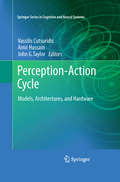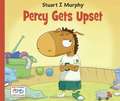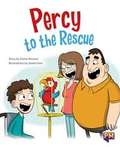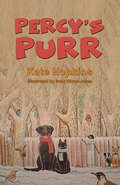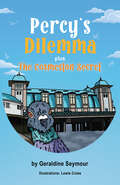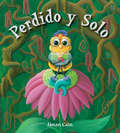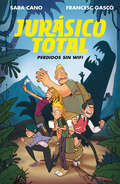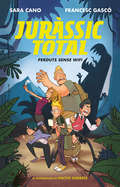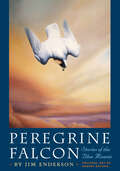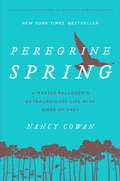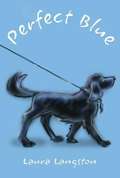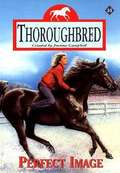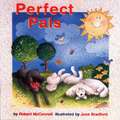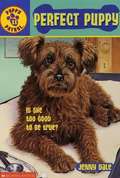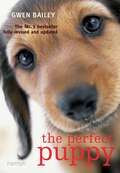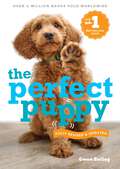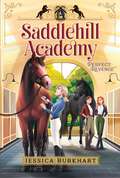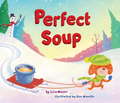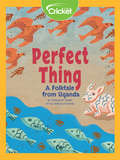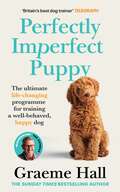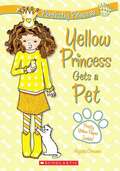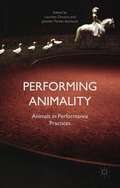- Table View
- List View
Pepper's Journal A Kitten's First Year: A Kitten's First Year (Mathstart 2)
by Stuart J. MurphyPepper's Journal is perfect for teaching calendars to first, second, and third graders. In her journal Lisa writes down all the important events of Pepper's first year—and readers will learn all about days, weeks, months, and years as they find out just how much fun a new kitten can be.
Perception-Action Cycle
by Amir Hussain Vassilis Cutsuridis John G. TaylorThe perception-action cycle is the circular flow of information that takes place between the organism and its environment in the course of a sensory-guided sequence of behaviour towards a goal. Each action causes changes in the environment that are analyzed bottom-up through the perceptual hierarchy and lead to the processing of further action, top-down through the executive hierarchy, toward motor effectors. These actions cause new changes that are analyzed and lead to new action, and so the cycle continues. The Perception-action cycle: Models, architectures and hardware book provides focused and easily accessible reviews of various aspects of the perception-action cycle. It is an unparalleled resource of information that will be an invaluable companion to anyone in constructing and developing models, algorithms and hardware implementations of autonomous machines empowered with cognitive capabilities. The book is divided into three main parts. In the first part, leading computational neuroscientists present brain-inspired models of perception, attention, cognitive control, decision making, conflict resolution and monitoring, knowledge representation and reasoning, learning and memory, planning and action, and consciousness grounded on experimental data. In the second part, architectures, algorithms, and systems with cognitive capabilities and minimal guidance from the brain, are discussed. These architectures, algorithms, and systems are inspired from the areas of cognitive science, computer vision, robotics, information theory, machine learning, computer agents and artificial intelligence. In the third part, the analysis, design and implementation of hardware systems with robust cognitive abilities from the areas of mechatronics, sensing technology, sensor fusion, smart sensor networks, control rules, controllability, stability, model/knowledge representation, and reasoning are discussed.
Percy Gets Upset
by Stuart J. MurphyPercy and his parents work throughout the day to calm Percy down and deal with his anger
Percy to the Rescue (Into Reading, Level O #30)
by Diana Noonan James HartNIMAC-sourced textbook <p><p> Tom is very excited about getting a new pet, Percy the parrot. Tom and his family try to teach Percy to talk, but Percy is more interested in watching TV. Then one day, Percy suddenly speaks, and everything changes!
Percy's Purr
by Kate HopkinsThese are the stories of two best friends. Percy is a young black cat and Pilot a bouncy black Labrador. These are heartwarming, amusing stories to curl up with and enjoy. Who has stolen the Halloween treats and exchanged them for stones? On a visit to Witch Tree Woods, will they solve the mystery of the woo noise? Can they escape Hogwood the grumpy wild boar? Will they save the baby owls from the nasty crow Corvus? At the Oakwood Green village fete they enter the pet talent competition with hilarious results and Pilot steals a hot dog. On holiday to Fossil Bay, Pilot digs up an enormous bone. What is it? At Christmas, they get up to mischief and have to help Santa as a consequence.
Percy’s Dilemma plus The Cosmeston Secret
by Geraldine SeymourPERCY’S DILEMMA As winter nears, Percy is very hungry when he spots an ad for Cardiff Bay. He ventures out on a disaster-prone journey to find food. Along the way, kind strangers help Percy before he discovers adventure and new friends. THE COSMESTON SECRET Dai and Nye are Cosmeston’s woodland elves and feather rangers, tasked with the important job of collecting fallen feathers for recycling. Exhausted from overwork, they oversleep one morning. Desperate for a solution, the elves seek help and are offered a problematic suggestion by Vincent the vole that causes chaos.
Perdido y Solo
by Janan CainRoonie B. Moonie yearns to be a great explorer like his hero, Christopher Columblebee. But while out adventuring one day, he wanders into a dark, scary place and finds himself in one unfamiliar situation after another. Approached by a suspicious stranger offering to help, Roonie must rely on his own instincts and his mother's safety rules to escape and find his way home. This delightfully illustrated story is both entertaining and educational, teaching children to stay calm and listen to their feelings when they are lost or in danger. An important tool for giving parents more peace of mind, this insightful story provides children with the knowledge they need to keep themselves secure in unforeseen situations.Zumbo Colmenar anhela ser un gran explorador como su héroe, Cristolabejo Colón. Sin embargo, embarcándose un día en una aventura, llega a conseguirse en un lugar oscuro y aterrador y se encuentra en una situación desconocida tras otra. Cuando un sospechoso desconocido se acerca ofreciéndole ayuda, Zumbo debe confiar en sus propios instintos y las normas de seguridad de su madre para escapar y encontrar el camino a casa. Esta historia deliciosamente ilustrada es entretenida y educativa a la vez y enseña a los niños a mantener la calma y escuchar a sus sentimientos cuando están perdidos o en peligro. Una herramienta importante para darles a los padres mayor tranquilidad, esta historia perspicaz les proporciona a los niños los conocimientos que necesitan para mantenerse seguros en las situaciones imprevistas.
Perdidos sin wifi (Serie Jurásico Total #Volumen 1)
by Sara Cano Francesc GascóVen a formar parte de «Jurásico Total», la nueva serie de ciencia ficción y aventuras, y prepárate para embarcarte en un viaje alucinante a la era de los dinosaurios. Un grupo de amigos ha encontrado un portal que les permite viajar a un lugar en el que no se extinguieron los dinosaurios. Juntos tendrán que hacer frente a un montón de peligros, conocerán de cerca los secretos de los dinosaurios y vivirán grandes aventuras. Leo, Carla, Dani, Elena y Lucas creían que se iban a pasar la tarde castigados en un laboratorio lleno de fósiles. Pero les esperaba la aventura más loca de sus vidas: un viaje a un lugar... ¡donde los dinosaurios siguen vivos! Ahora tienen que averiguar cómo volver a su mundo. Y rescatar a alguien perdido en esa tierra misteriosa. ¡Pero unos dientes mágicos les han dado unos poderes alucinantes! Aunque, antes de nada, todo equipo necesita un nombre. ¿Qué tal os suena...JURÁSICO TOTAL?
Perduts sense wifi (Sèrie Juràssic Total #Volumen 1)
by Sara Cano Francesc GascóVine a formar part de «Juràssic Total», la nova sèrie de ciència ficció i aventures, i prepara't per embarcar-te en un viatje al·lucinant a l'era dels dinosaures. Un grup d'amics ha trobat un portal que els permet viatjar a un lloc on no es van extingir els dinosaures. Junts hauran de fer front a un munt de perills, coneixeran de prop els secrets dels dinosaures i viuran grans aventures. En Leo, la Carla, en Dani, l'Elena i en Lucas estaven convençuts que passarien la tarda castigats en un laboratori ple de fòssils. Però els esperava l'aventura més boja de la vida: un viatge en un lloc... on els dinosaures estan vius! Un cop allà han de trobar la manera de tornar al seu món. I de rescatar una persona perduda en aquella terra misteriosa. Però troben unes dents mágiques que els donen uns poders al·lucinants! Encara que, primer de tot, l'equip necessita un nom. Què us sembla...JURÀSSIC TOTAL?
Peregrine Falcon: Stories of the Blue Meanie (Corrie Herring Hooks Series)
by James H. EndersonA superb success as a bird, combining great speed, aeronautical grace, and fearlessness...inhabitant of wild places, inaccessible cliffs, and skyscrapers...worldwide dweller, trans-equatorial migrant, and docile captive—the peregrine falcon stands alone among all others of its kind. Perhaps this is why so many varied people rushed to its aid when it faced decimation by pesticide poisoning. In this personal and highly entertaining memoir, Jim Enderson tells stories of a lifetime spent studying, training, breeding, and simply enjoying peregrine falcons. He recalls how his boyhood interest in raptors grew into an ornithological career in which he became one of the leading experts who helped identity DDT as the cause of the peregrine falcon's sudden and massive decline across the United States. His stories reveal both the dedication that he and fellow researchers brought to the task of studying and restoring the peregrine and the hair-raising adventures that sometimes befell them along the way. Enderson also seamlessly weaves in the biology and natural history of the peregrine, as well as anecdotes about its traditional and widespread use in falconry as an aggressive yet tractable hunter, to offer a broad portrait of this splendid and intriguing falcon.
Peregrine Spring: A Master Falconer's Extraordinary Life with Birds of Prey
by Nancy CowanNew York Times BestsellerPeregrine Spring, Nancy Cowan&’s memoir of her thirty years living intimately with raptors, gives us a new perspective on the relationship between humans and the natural world. Cowan shares her experiences running a world-famous falconry school, and the lessons she's learned from her birds. From retrieving her falcon from the local police &“lock up,&” to finding her husband in bed with a gyrfalcon, to a heart-breaking race to save her young peregrine from attack by a wild hawk, Cowan&’s life is a constant, ever-changing adventure. Cowan&’s birds have immersed her so much into their world that she has found herself courted by a Goshawk and bossed about by a Harris&’ Hawk. The book carries her readers along, so they, too, meet hawks and falcons in ways they never imagined possible.
Perfect Blue
by Laura LangstonMr. Lavender Blue is the perfect dog, and training him for the show ring is the perfect opportunity for twelve-year-old Erin Morris to show that she's responsible enough to have a dog of her own.
Perfect Image (Thoroughbred #44)
by Joanna CampbellWill Melanie save Image? Image is wild--perhaps too wild to train for the track. But she' s fast, and Melanie Graham wants nothing more than to be her jockey. If only Image's owner and trainer would let her work with the temperamental filly. Melanie isn't the only one interested in Image. Greedy Brad Townsend wants to add her to his breeding stock. Melanie is sure that Image's talent would wasted as a broodmare--the filly was born to run, and with the right rider she could win big. Will Melanie prove that Image can race before it's too late?
Perfect Pals
by Robert Mcconnell June BradfordCandy, Josie and Buddy are three canine friends whose days are filled with fun and friendship at the local park. But their happy days are threatened when two bullies named Riff and Raff drive them from their park, perhaps for good. When the three timid friends return, unable to keep themselves away from their favourite spot, the bullies are determined to do them serious harm. This book teaches a valuable lesson that every child should learn, that if good friends stand together, bullies soon find out that they’re not as tough as they thought.
Perfect Puppy (Puppy Patrol #11)
by Jenny DaleKing Street Kennel's newest visitor named Lucky seems to be the perfect puppy. Her playful charm soon wins her lots of friends--including little Sarah Parker. But as the Parker family soon discovers, Lucky is not as perfect as she seems. When Lucky leaves, Neil and Emily learn Lucky is hiding a dangerous secret.
Perfect Puppy: The No.1 bestseller fully revised and updated
by Gwen BaileyNEW EDITION OUT AUGUST 2024 Gwen Bailey's puppy care guide has helped hundreds of thousands of owners throughout the world raise a problem-free dog. Now, updated with the latest findings in canine behaviour and a completely new user-friendly design, this revised edition will teach you how to raise a problem-free dog. From housetraining to playing games, it will show you how to teach your dog good manners and build his confidence with the world around him. There are step-by-step training and socialisation plans as well as a guide to understanding and preventing biting, chewing and other problems.If you want your puppy to develop into a happy, well-behaved and friendly adult dog, you cannot afford to be without this book.
Perfect Puppy: The No.1 bestseller fully revised and updated
by Gwen BaileyNEW EDITION OUT AUGUST 2024 Gwen Bailey's puppy care guide has helped hundreds of thousands of owners throughout the world raise a problem-free dog. Now, updated with the latest findings in canine behaviour and a completely new user-friendly design, this revised edition will teach you how to raise a problem-free dog. From housetraining to playing games, it will show you how to teach your dog good manners and build his confidence with the world around him. There are step-by-step training and socialisation plans as well as a guide to understanding and preventing biting, chewing and other problems.If you want your puppy to develop into a happy, well-behaved and friendly adult dog, you cannot afford to be without this book.
Perfect Puppy: The classic puppy training book now fully revised and updated
by Gwen BaileyTHE NO.1 BEST-SELLING GUIDE - OVER 1/2 MILLION BOOKS SOLD WORLDWIDEGwen Bailey's ORIGINAL puppy training guide is back - FULLY REVISED and UPDATED for 2024!Packed with the most up-to-date findings in canine behaviour and sporting a brand-new, user-friendly design, this stunning edition will teach how to raise a problem-free dog. From housetraining to games and shared activities, learn how to teach your dog good manners and build their confidence in the world around them. Complete with step-by-step training and socialisation plans, as well as no-nonsense guides to understanding and preventing biting, chewing, aggression, and other problems.* BRAND NEW content and UPDATES throughout.* FRESH photography, that brings every lesson to life.* The LATEST methods and practices, to stay ahead in the ever-evolving world of dog training.* SUPER CLEAR, and USER-FRIENDLY layout.* Over half a million copies sold worldwide!Join hundreds of thousands of owners across the world who have already transformed their puppies into healthy, happy and obedient companions.
Perfect Puppy: The classic puppy training book now fully revised and updated
by Gwen BaileyTHE NO.1 BEST-SELLING GUIDE - OVER 1/2 MILLION BOOKS SOLD WORLDWIDEGwen Bailey's ORIGINAL puppy training guide is back - FULLY REVISED and UPDATED for 2024!Packed with the most up-to-date findings in canine behaviour and sporting a brand-new, user-friendly design, this stunning edition will teach how to raise a problem-free dog. From housetraining to games and shared activities, learn how to teach your dog good manners and build their confidence in the world around them. Complete with step-by-step training and socialisation plans, as well as no-nonsense guides to understanding and preventing biting, chewing, aggression, and other problems.* BRAND NEW content and UPDATES throughout.* FRESH photography, that brings every lesson to life.* The LATEST methods and practices, to stay ahead in the ever-evolving world of dog training.* SUPER CLEAR, and USER-FRIENDLY layout.* Over half a million copies sold worldwide!Join hundreds of thousands of owners across the world who have already transformed their puppies into healthy, happy and obedient companions.
Perfect Revenge (Saddlehill Academy #4)
by Jessica BurkhartFrom the author of the Canterwood Crest series comes the fourth book in a middle grade series about an equestrian boarding school as Abby works to bring up her grades while new students make waves at the stables.Abby can&’t believe she&’s officially been accepted to join other elite riders at the Sasha Silver&’s winter riding clinic! Training with the Queen of Canterwood is a dream come true…until she finds out her frenemy, Selly, is the only other Foxbury rider who got in. Even worse, Abby&’s recent grades haven&’t been so hot, and her dad says that if things don&’t shape up, she won&’t be allowed to attend the winter clinic. Then two surprise Canterwood transfers make things very interesting around the Foxbury stables. Are they coming with good intentions, or do they plan to upset the status quo?
Perfect Soup
by Ben Mantle Lisa MoserMurray the mouse likes everything to be perfect. Naturally, his perfect meal on a perfect winter day is Perfect Soup. But Murray doesn't have a carrot, and Perfect Soup isn't perfect without a carrot. With the snow falling around him, Murray ventures out of his little house to track down the final ingredient for his Perfect Soup. And there's no time for playing around--Murray is in a hurry.The farmer will be happy to provide a carrot if Murray will haul some logs. The horse will gladly haul the logs for Murray if he'll give him some fancy jingle bells in return. It looks like Murray just might get his carrot, but it only takes one grumpy person for a delicate chain of favors like this to fall apart. Can a friendly snowman help Murray make the soup perfect anyway? Author Lisa Moser and illustrator Ben Mantle have filled Murray's little town with richly colorful winter landscapes, wonderfully detailed cozy homes, a hilarious cast of quirky characters, and the absolute cutest talking snowman you have ever seen. Parents and kids alike won't be able to resist picking this book up again and again.From the Hardcover edition.
Perfect Thing
by Tolowa MollelLong ago a trickster rabbit cheated other animals in order to become more elegant. What happened when the other animals caught on? Find out in this tale from Uganda. The rabbit wants the fox’s tail, the fish’s scales, the bird’s feathers, and the leopard’s spots and greedily tosses away one feature for the next.
Perfectly Imperfect Puppy: The ultimate life-changing programme for training a well-behaved, happy dog
by Graeme HallTHE NEW BOOK FROM GRAEME HALL, THE SUNDAY TIMES BESTSELLING DOGFATHER I've been training puppies for years and I am yet to come across one who behaved perfectly at all times. With this book I really wanted to be realistic about the expectations we should have when training a puppy and demystify the process with clear, simple advice, based on science and experience. In this stress-free guide you will learn how to: · Choose the right puppy for your lifestyle, including the benefits of a rescue dog · Introduce them to the family, other pets and children · Tackle separation anxiety · Train your puppy, while building understanding and trust · Socialise them, so they grow into a happy, well-adjusted dog · Prevent behavioural problems later in life I love working with puppies because there is so much potential to make a lasting difference to a dog's life and to their owner's. If you can get it right (or right-ish), you are paving the way for a lifetime of reliably good behaviour. Happy training! Graeme Hall
Perfectly Princess #6: Yellow Princess Gets a Pet
by Alyssa CrowneA spunky series for any girl who dreams of being a princess. The book even looks magical --- it's printed on yellow pages!<p><p> Printed on YELLOW pages!<p> For as long as she can remember, Abby has wanted two things: to be a magical princess and to get a pet. And now one of her dreams is about to come true --- she's adopting a pet!<p> At first, Abby can't make up her mind about what animal to get. A yellow canary? A sweet little bunny? A fluffy white kitten? But Abby's in for a surprise. The perfect pet for this princess may be the last thing she expects!<p> Fun princess craft ideas are included in the back of the book!
Performing Animality
by Jennifer Parker-Starbuck Lourdes OrozcoPerforming Animality provides theoretical and creative interventions into the presence of the animal and ideas of animality in performance. Animals have always played a part in human performance practices. Maintaining a crucial role in many communities' cultural traditions, animal-human encounters have been key in the development of performance. Similarly, performance including both living animals and/or representations of animals provides the context for encounters in which issues of power, human subjectivity and otherness are explored. Crucially, however, the inclusion of animals in performance also offers an opportunity to investigate ethical and moral assumptions about human and non-human animals. This book offers a historical and theoretical exploration of animal presence in performance by looking at the concept of animality and how it has developed in theatre and performance practices from the eighteenth century to today. Furthermore, it points to shifts in political, cultural, and ethical animal-human relations emerging within the context of animality and performance.

